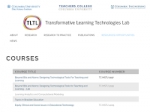
NEWS: Chatbots.org survey on 3000 US and UK consumers shows it is time for chatbot integration in customer service!read more..
1st International Workshop on Multimodal Learning Analytics

Multimodal learning analytics, learning analytics, and educational data mining all are emerging disciplines concerned with developing techniques to more deeply explore unique data in educational settings. They use the results based on these analyses to understand how students learn. Among other things, this includes how they communicate, collaborate, and use digital and non-digital tools during learning activities, and what the impact of these tools is on acquiring new skills and knowledge. Past research on learning analytics has aimed to model students’ knowledge and motivation during learning, to contribute to understanding learning dynamics during computer-supported and collaborative exchange, to diagnose students’ failure to progress during learning activities, and to adapt learning activities to students’ limitations and learning status. More generally, advances in learning analytics are expected to contribute new empirical findings, theories, methods, and metrics for understanding how students learn. They also can contribute to improving pedagogical support for students’ learning through assessment of new digital tools, teaching strategies, and curricula.
The most recent direction within this area is multimodal learning analytics, which emphasizes the analysis of natural rich modalities of communication during situated learning activities. This includes students’ speech, writing, and nonverbal interaction (e.g., gestures, facial expressions, gaze). A primary objective of multimodal learning analytics is to analyze coherent signal and activity patterns in order to uncover entirely new learning-oriented phenomena. Another is to develop a better collection of converging metrics for learning-related behavior and landmarks. These include metrics that eventually could be analyzed unobtrusively, continuously, automatically, and in natural classroom environments and mobile settings.
Progress in these areas will transform our ability to identify and stimulate effective learning, support more rapid feedback and responsive intervention, and facilitate learning in more diverse students and contexts.
New Comment
Only registered members are allowed to comment. or login
or login
